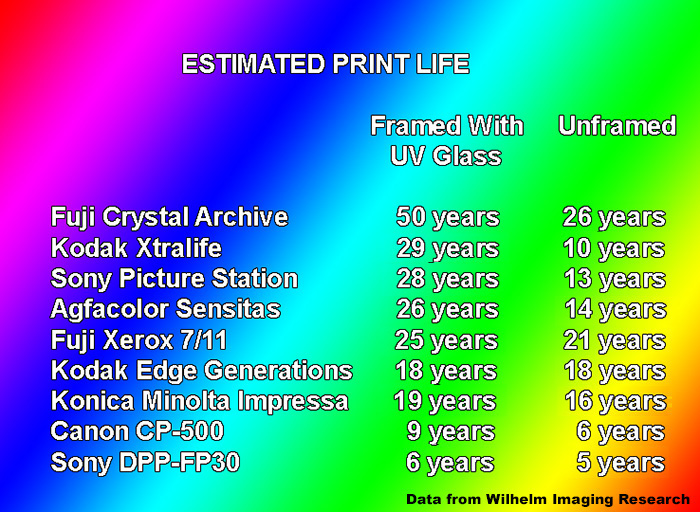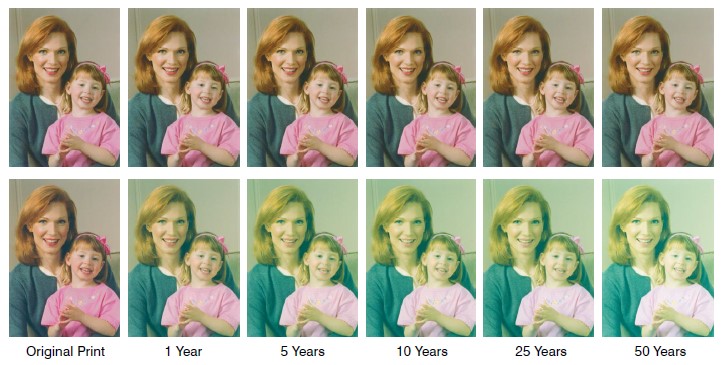Would you rather have a high quality print that will last up to 50 years, or a print that will fade in 5 years? That’s not all. The print with a very short life expectancy might cost more than the better quality print. People buy short life span prints all the time. Why? Because they don’t have the right information, and they may have no idea that prints have such widely different life spans.
No one tells them that the fancy Noritsu printer behind the counter uses Kodak Edge Generations paper that will fade in 18 years, while the Kodak Picture Maker in the lab across town uses Kodak Xtralife paper that will last 29 years (and for about the same price). Or that the Frontier 370 minilab uses Fuji Crystal Archive Paper that will last 50 years or more when framed under glass (and costs less than other papers that have half the life span). For obvious reasons, manufacturers don’t advertise the life spans of their photographic papers if the life span is pretty short.
So before you head to the local big box store, drug store, photo kiosk or minilab, it is a good idea to ask yourself how long your prints will last before they start fading. It may surprise you to know that you can get better prints with a much longer life span (and usually for less money) by going to one of the better online labs instead of heading for your local photo lab. See the link below for the best online labs.
Out of a sense of curiosity (and sometimes necessity when I am on the road), I have some of my digital files printed at a variety of big box stores, drug stores, photo kiosks, and mini-labs. I check out the color quality of course, but I am just as interested in the equipment, processes, and paper they use so I can check out the expected life span of the prints. Sometimes I ask what kind of processing they use. Sad to say, some photo lab techs have no idea what the processing is, other than looking at the name on the machine. They just push the buttons they have been taught to push. There are glimmers of hope and some mini-lab techs are very knowledgeable, but don’t expect all mini-lab techs to be up on the latest print life research.
It won’t surprise you to learn that the color quality at these labs is all over the place from quite good to pretty sad. Blue mid-day sky should be blue, not some strange shade of green; and human skin shouldn’t be orange.
Of equal concern is the life expectancy of the prints from these labs. Henry Wilhelm of Wilhelm Imaging Research is one of the leading international experts on the life span (which he calls “permanence rating”) of photographic materials and processes, including negative film, slide film, analog prints, and digital prints. I have been following his research for 30 years and I still have my original copy of this article from the June 1990 issue of Popular Photography. Wilhelm does accelerated print aging to estimate the life of prints under normal viewing conditions. The graphic at the top of this article has the projected print life (before objectionable fading or color shifts) of several printing processes (there are dozens), including a couple of 4×6 inch dye-sub printers. You can check out a lot more options and all kinds of information at Wilhelm’s web site.
Wilhelm also does research on the printers people use at home. Some brands of printers and the OEM inks and papers that go with them have a much longer life span than other brands. Using aftermarket inks in a name brand printer can dramatically decrease the life span of a print. You have a choice between a print that will last 50 years with minimal fading to a print that will have significant fading in less than 5 years.
The fact is the color on some prints fade away much, much faster than others. That may not matter for the annual Christmas card you send out, but if you are sending an 8×10 or 11×14 inch print of a precious family photo to a relative, it would be nice if it didn’t fade in 6 years. If you pick the right photo lab, your prints can last a lot longer.
Color quality and life span are my primary concerns, but I do check prices. It just so happens that the price at my favorite online labs is about the same as at the local labs. Sometimes the price for a poor quality, short life span print at a local lab is more expensive than a high quality, long life span print at one of my favorite online labs.
At my favorite online labs you can get an 8X10 print from the best processes on the best photographic papers for around $3.00 to $8.00 depending on the lab and the type of paper you choose (not counting shipping). These labs have special equipment that turn digital files into an analog prints using a digital enlarger to expose the analog photographic paper before it is processed in traditional wet chemistry. One of my favorite labs (Aspen Creek Photo) will take your digital file and create an 8×10 print on Fuji Crystal Archive Paper for $5.00 – $8.00 depending on the paper finish you want. Fuji Crystal Archive Paper has a display life of 50 years, the longest display life of any R4-A (analog) paper. If you have been to one of my recent photo workshops or photography exhibits, you’ve seen my digital files printed as 16×24 and 20×30 inch prints on Fuji Crystal Archive Paper. MPIX, another of my favorite labs, does 8×10 prints for $3.29 to $3.69, depending on the paper you choose.
My favorite labs also provide exotic choices like the gorgeous Fuji Pearl paper (with a metallic look), Kodak Metallic for an even stronger metallic look, canvas wraps (also called gallery wraps), and printing on actual aluminum sheets. Exotic papers will cost you a bit more. Canvas and metal a lot more.
The bottom line is the online labs I recommend (first article linked below) will give you very high color quality, a longer print life, and usually (except for some of the more exotic processes) for the same amount of money or even less than at a typical local lab. The first article linked below also has tips on how to prepare your digital files before you send them off to the lab.
Links
My favorite online labs are in this article: How To Get The Best Results From The Best Online Photo Labs
Aspen Creek Photo – There are many paper options to choose from including Fuji Crystal Archive
This is one in a series of articles that will guide you to the best of all things photographic. The rest of the series is here: Buyer’s Guide: Recommendations For The Best Photography Equipment, Software, Books, Magazines, DVDs, Online Photo Labs and More.


